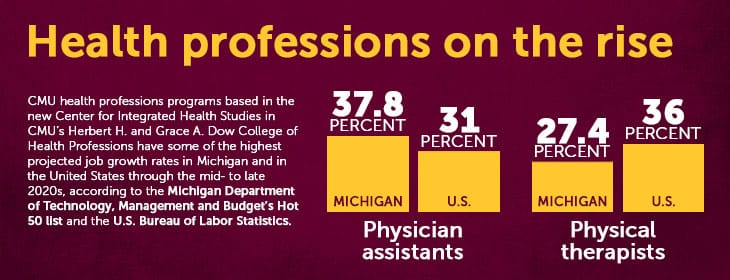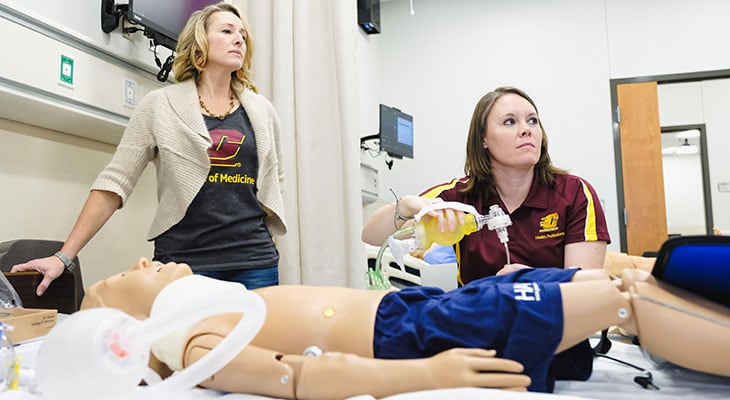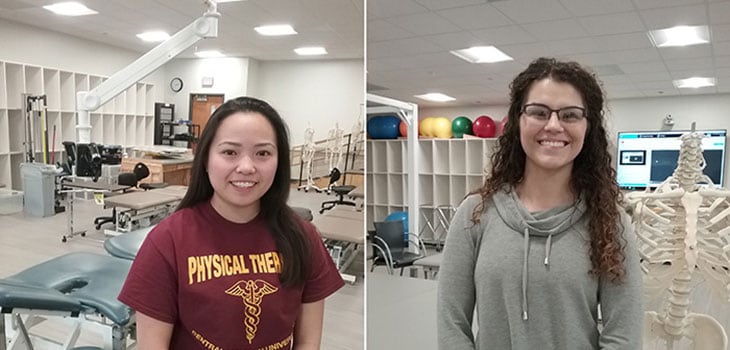High tech for high job demand
Health professions’ new addition prepares students for fast-growing careers
As Tom Masterson, dean of The Herbert H. and Grace A. Dow College of Health Professions , watches students rush into the labs and classrooms of the new $26 million addition to the Health Professions Building, he envisions both their future and the future of the college.
"Our students and those to come will not only have access to the latest and greatest technology in the world, but the space in which to use it," he said of the 50,000-square-foot building.
"The education these students will get because of this addition makes us the go-to college of health professions in the state."
Job statistics support Masterson's confidence.
The health professions being taught in the expansion have some of the highest projected job-growth rates in Michigan and the United States through the mid- to late 2020s, according to the Michigan Department of Technology, Management and Budget's Hot 50 list and the U.S. Bureau of Labor Statistics. For example:
- Physician assistants: 37.8% in Michigan; 31% in U.S.
- Physical therapists: 27.4% in Michigan; 36% in U.S
Other health professions being taught in the college have similar high job growth rates in the U.S. through the late 2020s, such as 16% for audiology and 27% for Speech-language, pathology.

Modern labs, collaborative learning
Top-of-the-line laboratories and collaborative learning techniques are the keys to jobs today and in the future, said Masterson and Amy Malheim, director of the Interprofessional Education and Practice Center within the addition.
CMU is charging ahead on both fronts.
The greatest impact on lab space will be felt by the physician assistant and physical therapy programs, which have moved to the addition, Masterson said.
"Any eighth grader who walks through our complex now and has any idea of becoming a PA or a PT, they are going to want to come here," he said.
The move also opens up space for the programs housed in the main building, creating a win for the entire college, he added.

Physician assistant labs
The PA program has gone from one small lab to two that are four times the size. They include a classroom, mannequins for simulations and exam rooms.
The space was built to accommodate an expected 50% enrollment increase, from 40 to 60 students, Masterson said.
The former PA lab in the Health Professions Building will be renovated this spring and turned into an exercise physiology lab, and two new faculty members — an audiologist and a speech-language pathologist — will get research labs in one of the vacated PT labs.
Scott Massey, director of the PA program, said the new space creates many advantages for learning, including:
- Students will be able to work together in one lab as opposed to being scattered into multiple rooms in the Carls Center for Clinical Care and Education.
- The new patient simulations will help students learn not only how to give traditional exams but also how to work with intensive care patients.
- The PA classrooms is connected to a lab, allowing students to be taught in one room and then immediately practice the skill under supervision in the lab.
"The expansion is the single best improvement this program has had," Massey said. "This elevates our game."
Physical therapy labs
The PT space has gone from two medium-sized labs to two new large labs that will accommodate the program's recent growth to 60 students, including its cohort at Michigan Technological University in Houghton, Michigan.
Students no longer have to switch out lab equipment to make room for another group, Masterson said, and the exam tables in the two new labs can accommodate a variety of training, from orthopedic and manual therapy to neurology.
Other advantages to the new space:
- The neurological lab will be larger and include an overhead harness walking system.
- The community outreach therapy program MOVE! for Health will use the new space instead of participants being dispersed in the Carls Center.
"With the new space and equipment, students can be sure that they will have the best learning experiences to prepare them for the field," said PT faculty member Jamie Haines.

Students' reaction
First-year PT students Quincy Platte of Fowler, Michigan, and Michaela Javier, of East Lansing, Michigan are excited about what the new facility means for their education and job prospects.
"Now we have the same equipment being used in the most modern clinics today," Javier said. "That and our hands-on experiences will definitely help us get jobs."
They both agree that the added lab space and new viewing screens will be greatly appreciated.
In the past, students sometimes had to jostle for a good spot around a table to watch a technique being demonstrated, but the new high-definition cameras at the tables and large viewing screens eliminate that issue.
What hasn't changed is the top-notch professors who are dedicated to help students succeed, they said.
"This combination will keep us competing for jobs," Platte said.
IEPC spells collaboration
"In today's world, health care professionals need to be trained in real-life environments," Masterson said. "That includes learning and working alongside colleagues with different clinical training using high-definition mannequins and students role-playing as patients."
The Interprofessional Education and Practice Center is designed to facilitate the sharing of knowledge and skills among faculty and their students pursuing jobs in the health professions, such as nursing, exercise science, communication sciences and disorders, and athletic training, in addition to PA and PT.
The new space with its connected labs and faculty viewing spaces will bring those students together to collaborate on health care scenarios they will face in the real world, Malheim said.
She intends to have each of the health professions working with at least one other health profession this first year and expand to two or more next year once everyone learns the capabilities of the center.
"Working together results in better patient care," she emphasized. "That's our main mission."
She and Masterson are on the same page.
"Five years from now, I want our college to be known for putting out health professionals that are trained in interprofessional education and elevating public health," he said.